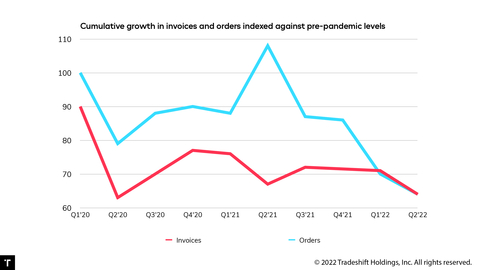- Cocktail of challenges triggers a successive quarterly drop in overall trade activity.
- Invoice traffic drops by 7 points as softening orders start to bite.
- Average value of an invoice on Tradeshift has risen 11% since the beginning of the year.
Global supply chain activity slowed for the second quarter in a row in Q2, dropping by a further 6 points against forecast estimates. That’s according to the latest Index of Global Trade Health from Tradeshift, the supply chain commerce platform facilitating digital trade transactions between B2B buyers and suppliers.
This press release features multimedia. View the full release here: https://www.businesswire.com/news/home/20220719005676/en/

Order volumes fell further against the expected growth rate in Q2. Growth in invoice volumes is also starting to slide against expected levels (Graphic: Business Wire)
Order volumes on Tradeshift’s platform fell to further below expectation in Q2, sliding by a further 6 points following a 7-point drop in the previous quarter. The lack of fresh orders is beginning to impact suppliers, who had only recently been struggling to cope with surging demand. The number of invoices submitted by suppliers dropped by 7 points in Q2, the most significant slowdown in a year.
Orders might be softening, but Tradeshift’s analysis suggests costs have risen sharply since the beginning of the year. The average value of an invoice submitted on Tradeshift’s platform has increased by 11% since the start of 2022, compared to a more modest 3.5% rise in 2021.
“Many of the current supply chain challenges, including inflation, have roots in the pandemic,” said Christian Lanng, CEO and co-founder at Tradeshift. “Some of these problems are transitory, but the bigger issues, including labor shortages, geopolitical tension, and energy transition, are structural and risk becoming entrenched unless businesses take decisive action now.”
Tradeshift’s analysis reveals a remarkably similar pattern across regional supply chains the world over:
- Total trade activity in the UK and the Eurozone dropped by 5 points, with new orders and supplier invoices tracking below the expected range.
- US supply chains fared slightly better than the global average. Transaction volumes were 4 points below the expected range in Q2, but the volume of new orders remains low.
- Chinese trade activity had another challenging quarter as new lockdown measures in key cities contributed to another 7-point fall in transaction volumes against the expected range.
Tradeshift’s data suggests that declining demand is also leading to a cooling-off in activity across the transport and logistics sector. Transaction volumes across the industry dipped below the expected range for the first time in a year after a 5-point fall in activity compared to the previous quarter.
Manufacturing and retail trade activity also remained below the expected range. Technology spending recovered sharply in Q2, with activity tracking well within the predicted range.
“It would be an entirely natural response for business leaders to want to batten down the hatches and wait for the current storm to pass,” said Lanng, “but many of the same problems supply chains face today will still be there a year from now. How long can a business hold its breath before it runs out of air?”
“The majority of business leaders I speak to are keeping their eyes on the horizon and pressing ahead with much-need investments in technology that will allow them to become more agile, resilient, and sustainable.”
About Tradeshift’s Index of Global Trade Health
Tradeshift’s Index of Global Trade Health analyzes business-to-business transaction volumes (orders processed from buyers and invoices processed from suppliers) submitted via the Tradeshift platform to offer a perspective of how external events may be impacting business-to-business commerce in a variety of different regions and sectors across the globe.
About Tradeshift
Tradeshift is a market leader in e-invoicing and accounts payable automation and an innovator in B2B marketplaces and providing access to supplier financing. Its cloud-based platform helps buyers and suppliers digitize invoice processing, automate accounts payable workflows and scale quickly. Headquartered in San Francisco, Tradeshift’s vision is to connect every company in the world, creating economic opportunity for all. Today, the Tradeshift platform is home to a rapidly growing community of buyers and sellers operating in more than 190 countries. Find out more at: Tradeshift.com
Forward-looking statements
Any statements contained in this document that are not historical facts are forward-looking statements as defined in the U.S. Private Securities Litigation Reform Act of 1995. Tradeshift undertakes no obligation to publicly update or revise any forward-looking statements. All forward-looking statements are subject to various risks and uncertainties that could cause actual results to differ materially from expectations.
© 2022 Tradeshift Holdings Inc. All rights reserved.
View source version on businesswire.com: https://www.businesswire.com/news/home/20220719005676/en/
Contacts
Press contact:
Harry Ronaldson
harry.ronaldson@tradeshift.com





